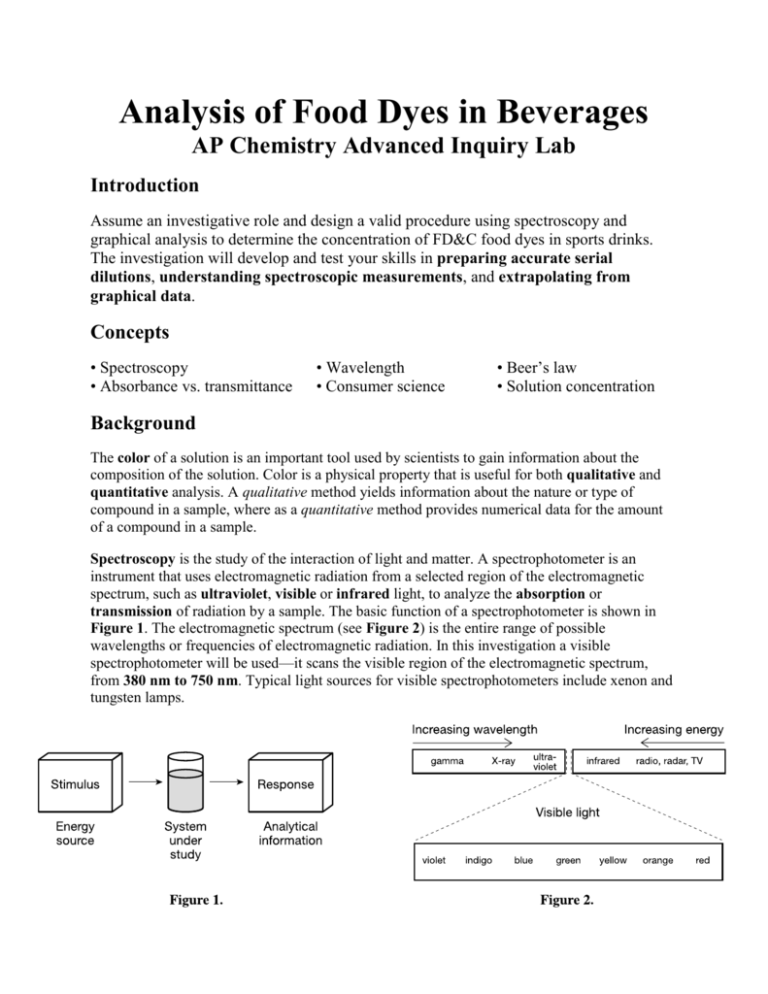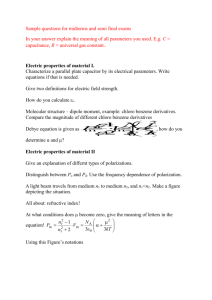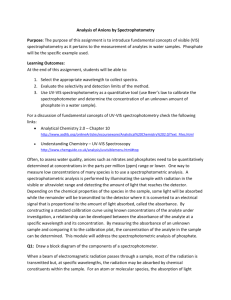Analysis of Food Dyes in Beverages AP Chemistry
advertisement

Analysis of Food Dyes in Beverages AP Chemistry Advanced Inquiry Lab Introduction Assume an investigative role and design a valid procedure using spectroscopy and graphical analysis to determine the concentration of FD&C food dyes in sports drinks. The investigation will develop and test your skills in preparing accurate serial dilutions, understanding spectroscopic measurements, and extrapolating from graphical data. Concepts • Spectroscopy • Absorbance vs. transmittance • Wavelength • Consumer science • Beer’s law • Solution concentration Background The color of a solution is an important tool used by scientists to gain information about the composition of the solution. Color is a physical property that is useful for both qualitative and quantitative analysis. A qualitative method yields information about the nature or type of compound in a sample, where as a quantitative method provides numerical data for the amount of a compound in a sample. Spectroscopy is the study of the interaction of light and matter. A spectrophotometer is an instrument that uses electromagnetic radiation from a selected region of the electromagnetic spectrum, such as ultraviolet, visible or infrared light, to analyze the absorption or transmission of radiation by a sample. The basic function of a spectrophotometer is shown in Figure 1. The electromagnetic spectrum (see Figure 2) is the entire range of possible wavelengths or frequencies of electromagnetic radiation. In this investigation a visible spectrophotometer will be used—it scans the visible region of the electromagnetic spectrum, from 380 nm to 750 nm. Typical light sources for visible spectrophotometers include xenon and tungsten lamps. Glass cuvettes or test tubes may be used as sample cells for visible spectrophotometers. More specialized spectrophotometers require quartz cells, which are “invisible” to and do not absorb ultraviolet radiation. In addition to the energy source used in spectrophotometers, a diffraction grating called a monochromator is also incorporated. The monochromator spreads the beam of light into the light’s component wavelengths. The desired wavelength is then focused onto the sample cell to detect any absorption or emission of light by a substance in a sample. Spectrophotometry is an analytical procedure that uses electromagnetic radiation to measure the concentration of a substance. The success of a spectrophotometric technique requires that the absorption of light by the substance being analyzed must be distinct or different from that of other chemical species in solution. How do scientists select the desired wavelength for spectrophotometry? The absorption of visible light by a substance results from electron transitions, that is, the promotion of a ground state electron to a higher energy atomic or molecular orbital. Both light energy and electron energy levels are quantized, so that the specific wavelength of light absorbed by a substance depends on the energy difference between two electron energy levels. The optimum wavelength for spectrophotometric analysis of a substance is selected by measuring the visible spectrum of the substance, corresponding to a plot of absorbance (A) versus wavelength (λ, “lambda”). The Food and Drug Administration approve only seven unique dyes for use in foods, drugs, and cosmetics. These seven FD&C dyes give rise to the entire palette of artificial food colors. Three FD&C dyes, FD&C Blue 1, FD&C Red 40, and FD&C Yellow 5, are discussed in this advanced inquiry lab for the analysis of sports drinks and other beverages. The structure of FD&C Blue 1 is shown in Figure 3. Notice the extensive series of alternating single and double bonds (also called conjugated double bonds) in the center of the structure. This feature is characteristic of intensely colored organic dyes and pigments. Every double bond added to the system reduces the energy difference between the bonding and nonbonding molecular orbitals so that the resulting energy gap corresponds to visible light. A solution containing FD&C Blue 1 appears blue under normal white light—blue is the color of light transmitted by the solution. The colors or wavelengths of light that are absorbed by this solution are complementary to the transmitted color. A color wheel (see Figure 4) provides a useful tool for identifying the colors or wavelengths of light absorbed by a substance. The blue solution absorbs orange light and we would expect the visible spectrum of FD&C Blue 1 to contain a peak in the 600−640 nm region. The optimum wavelength for spectrophotometric analysis of a dye solution is generally determined from the wavelength of maximum absorbance (abbreviated λmax, or “lambda max”). The value of lambda max for FD&C Blue 1 is 630 nm. The wavelength of light absorbed by a substance is characteristic of its molecular or electronic structure. The intensity of light absorbed depends on the amount of the substance in solution. Generally, the more concentrated the solution, the more intense the color will be, and the greater the intensity of light the solution absorbs. A digital spectrophotometer measures both the percent transmittance of light and the absorbance. When light is absorbed, the radiant power (P) of the light beam decreases. Transmittance (T) is the fraction of incident light (P/Po) that passes through the sample (see Figure 5). The relationships between transmittance and percent transmittance (% T) and between transmittance and absorbance (A) are given in Equations 1 and 2, respectively. The amount of light absorbed by a solution depends on its concentration (c) as well as the path length of the sample cell (b) through which the light must travel. See Equation 3, which is known as Beer’s law. The constant ε(“epsilon”) in the equation is a characteristic of a substance and is known as the molar absorptivity coefficient. Experiment Overview The purpose of this advanced inquiry lab is to use spectroscopy and graphical analysis to determine the concentration of dye in a sports drink. The investigation begins with an introductory activity for preparing a series of standard dilutions of an FD&C Blue 1 stock solution and measuring the percent transmittance of each. The results will be analyzed graphically to identify an optimum linear relationship among various functions (T, % T, log T and A) for a Beer’s law calibration curve. The procedure provides a model for guided-inquiry analysis of the concentration of food dye(s) in sports drinks and other consumer beverages. Additional dyes, FD&C Yellow 5 and FD&C Red 40, are also available for optional extension or cooperative class studies. Pre-Lab Questions The visible absorption spectrum for FD&C Blue 1 is shown in Figure 6. The estimated concentration of the dye was 7.0 μM (7.0 × 10–6 M). 1. What would be an optimum wavelength for measuring the absorbance versus concentration of a series of FD&C Blue 1 dye solutions? Explain your answer. Absorbance measurements are most accurate and sensitive in the range 0.2–1.0. 2. To construct a calibration curve, a series of known concentration standards is prepared. Using the estimated concentration of the FD&C Blue 1 stock solution, determine the concentration of each of the following dilutions. Hint: M1V1 = M2V2 (Check website discussion for more help) 3. Using the information provided in Question 1, predict the absorbance of each solution A–H at the optimum wavelength. Refer to Equation 3 in the Background. The value of εis 130,000 M–1 cm–1 and b = 1 cm. (Concentration (c) needs to be in M) Materials (for each lab group) 50 mL of FD&C Blue 1 stock solution, 10 mL of Blue consumer sports drink, 50 mL of distilled or deionized Water, Beakers, 3–8 Cuvettes or test tubes, Kimwipes or lens tissues, 10 mL Pipet, Pipet bulb, Spectrophotometer or colorimeter, Test tube rack Safety Precautions The FD&C dyes are slightly hazardous by eye and skin contact. The dyes have been stored with other, nonfood-grade chemicals and are not for consumption. Avoid contact with eyes, skin, and clothing. Wear chemical splash goggles, chemical-resistant gloves, and a chemical-resistant apron. Wash hands thoroughly with soap and water before leaving the laboratory. Please follow all laboratory safety guidelines. Introductory Activity 1. Turn on the spectrophotometer and allow to warm up for 15–20 minutes. 2. Based on the maximum absorbance of the dye being tested, select the appropriate wavelength on the spectrophotometer or colorimeter. (Remember complementary) 3. Read the entire procedure. Construct an appropriate data table to record measurements and the results of calculations. Note: As part of a cooperative lab activity, your instructor may assign different groups to prepare and analyze different solutions, and to graph the results. Each group will need to transcribe data and analyze the results for all solutions in order to complete the guided-inquiry activity. (Please include only your color for your data table) 4. Obtain approximately 50 mL of stock solution containing FD&C Blue 1 (Yellow 5, or Red 40) dye. 5. Using a serological pipet for accurate volume measurements, dilute the stock solution as indicated in the following table to prepare 10 mL each of a series of standard solutions, B–H. Carefully mix each solution. Hint: To avoid contaminating the stock solution, use different pipets for the stock solution and the distilled water. Please rinse the glass stirring rod every time after mixing. 6. Use the “blank” test tube (H) to set the 100% transmittance value for the spectrophotometer at the desired, optimum wavelength for this study. 7. Measure and record the percent transmittance (% T) of the stock solution and each standard solution (B–G) at the optimum wavelength. Remember to handle the test tubes only at the top and to polish the test tube with lens tissue. To avoid spills, do not place test tubes in the spectrophotometer if they are more than 75% full. Remove some solution if needed from each test tube before inserting it in the instrument. 8. Convert % T to transmittance (T) for each measurement, and calculate the appropriate values of both log T and −log T. Record all results. Use Beer’s law to calculate the precise concentration of FD&C Blue 1 in the stock solution. The molar absorptivity (ε) of FD&C Blue 1 is 130,000 M−1 cm−1, FD&C Red 40 is 25,900 M–1 cm–1, and FD&C Yellow 5 is 27,300 M–1 cm–1 and the path length (b) is 1 cm. Record the micromolar (μM) concentration (1μM=1×10–6 M) in your data table. 9. Prepare separate graphs in Excel of (a) % T, (b) T, (c) 1/T, (d) log T, and (e) –log T (on the y-axis) versus dye concentration (on the x-axis) for each solution. Note: Dye concentrations were calculated in the Pre-Lab Questions using the estimated concentration of the stock solution. Please print and paste your 5 graphs in your lab notebook. Make sure it is titled and labeled correctly. Guided-Inquiry Design and Procedure Concentration of FD&C Blue 1 (Yellow 5 or Red 40) in Beverages 1. Based on the graphs obtained in the Introductory Activity, identify the optimum linear relationship or calibration curve for quantitative analysis of the concentration of an “unknown” solution containing FD&C Blue 1 (Yellow 5 or Red 40) food dye. 2. Which graph would provide the most accurate means to determine the concentration of an “unknown” solution whose transmittance has been measured spectroscopically? Explain in terms of Beer’s law and give an example of how the analysis would be carried out. 3. Consult the ingredients label for a blue (yellow or red) -colored sports drink or other consumer beverage. Identify the dyes that are present and explain whether the beverage can be analyzed using the calibration curve described above. 4. Obtain the necessary spectroscopic data for the beverage containing FD&C Blue 1 (Yellow 5 or Red 40) food dye. Recall that absorbance measurements are most accurate in the range of A values from 0.2 to 1.0. Treat the beverage sample if needed to make sure the data is in the acceptable range. 5. Determine the concentration (micromolar, μM) of the dye in the beverage and calculate the amount (mass) of dye in milligrams per liter of the beverage. The molar mass of FD&C Blue 1 is 793 g/mole (Yellow 5 is 534 g/mole, and Red 40 is 496 g/mole). AP Chemistry Review Questions Integrating Content, Inquiry and Reasoning (please answer the following after your conclusion, write as if answering a Free Response question on a Chem AP Test) 1. Calculate the value of % T for an absorbance value A = 1.5 (Equation 2). Using this result, explain why absorbance measurements A > 1 may not be accurate. 2. Spectrophotometric studies can be conducted on any colored compound. The transition metal group of the periodic table exhibits a wide array of different colored compounds. The complex ion tetraamminecopper(II) contains four ammonia molecules covalently bonded to a copper(II) ion. In aqueous solutions, Cu2+ ions will bond to four water molecules in a square planar geometry. The solution is a light blue color. The water molecules can be displaced by ammonia molecules, which form more stable complex bases than water. The appearance of the intense dark blueviolet color of the [Cu(NH3)4]2+ ion is often used as a positive test to verify the presence of Cu2+ ions. a. Write a balanced chemical equation for the reaction of copper(II) sulfate and concentrated ammonia to produce tetraamminecopper(II) sulfate. b. [Cu(NH3)4] 2+ solutions exhibit a deep blue-violet color. How can you use spectrophotometry to confirm that this reaction has occurred and that the product formed is in fact tetraaminecopper(II) sulfate? Would you expect the wavelength of maximum absorbance (λmax) for Cu(NH3)42+ to be greater than or less than λmax for Cu2+(aq)? Explain. 3. The electron transitions responsible for the colors of transition metal ions involve “d” transition states. Why are zinc ions colorless in aqueous solution?










